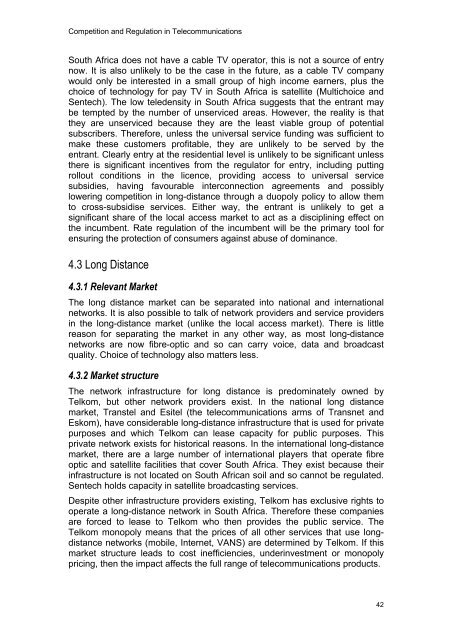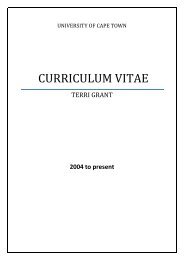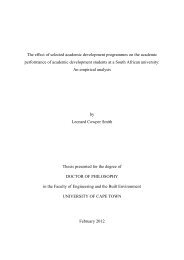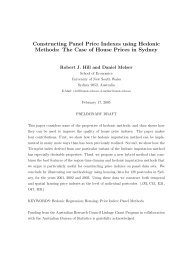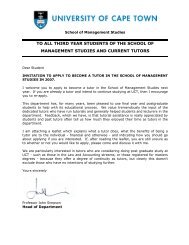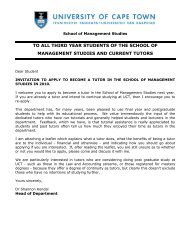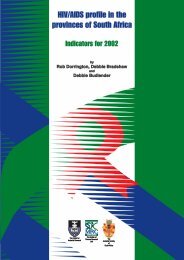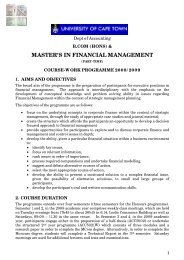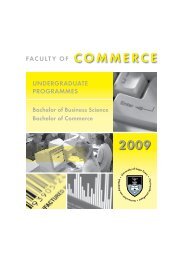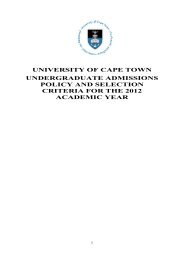Competition and Regulation in the Telecommunications Industry in ...
Competition and Regulation in the Telecommunications Industry in ...
Competition and Regulation in the Telecommunications Industry in ...
Create successful ePaper yourself
Turn your PDF publications into a flip-book with our unique Google optimized e-Paper software.
<strong>Competition</strong> <strong>and</strong> <strong>Regulation</strong> <strong>in</strong> <strong>Telecommunications</strong>South Africa does not have a cable TV operator, this is not a source of entrynow. It is also unlikely to be <strong>the</strong> case <strong>in</strong> <strong>the</strong> future, as a cable TV companywould only be <strong>in</strong>terested <strong>in</strong> a small group of high <strong>in</strong>come earners, plus <strong>the</strong>choice of technology for pay TV <strong>in</strong> South Africa is satellite (Multichoice <strong>and</strong>Sentech). The low teledensity <strong>in</strong> South Africa suggests that <strong>the</strong> entrant maybe tempted by <strong>the</strong> number of unserviced areas. However, <strong>the</strong> reality is that<strong>the</strong>y are unserviced because <strong>the</strong>y are <strong>the</strong> least viable group of potentialsubscribers. Therefore, unless <strong>the</strong> universal service fund<strong>in</strong>g was sufficient tomake <strong>the</strong>se customers profitable, <strong>the</strong>y are unlikely to be served by <strong>the</strong>entrant. Clearly entry at <strong>the</strong> residential level is unlikely to be significant unless<strong>the</strong>re is significant <strong>in</strong>centives from <strong>the</strong> regulator for entry, <strong>in</strong>clud<strong>in</strong>g putt<strong>in</strong>grollout conditions <strong>in</strong> <strong>the</strong> licence, provid<strong>in</strong>g access to universal servicesubsidies, hav<strong>in</strong>g favourable <strong>in</strong>terconnection agreements <strong>and</strong> possiblylower<strong>in</strong>g competition <strong>in</strong> long-distance through a duopoly policy to allow <strong>the</strong>mto cross-subsidise services. Ei<strong>the</strong>r way, <strong>the</strong> entrant is unlikely to get asignificant share of <strong>the</strong> local access market to act as a discipl<strong>in</strong><strong>in</strong>g effect on<strong>the</strong> <strong>in</strong>cumbent. Rate regulation of <strong>the</strong> <strong>in</strong>cumbent will be <strong>the</strong> primary tool forensur<strong>in</strong>g <strong>the</strong> protection of consumers aga<strong>in</strong>st abuse of dom<strong>in</strong>ance.4.3 Long Distance4.3.1 Relevant MarketThe long distance market can be separated <strong>in</strong>to national <strong>and</strong> <strong>in</strong>ternationalnetworks. It is also possible to talk of network providers <strong>and</strong> service providers<strong>in</strong> <strong>the</strong> long-distance market (unlike <strong>the</strong> local access market). There is littlereason for separat<strong>in</strong>g <strong>the</strong> market <strong>in</strong> any o<strong>the</strong>r way, as most long-distancenetworks are now fibre-optic <strong>and</strong> so can carry voice, data <strong>and</strong> broadcastquality. Choice of technology also matters less.4.3.2 Market structureThe network <strong>in</strong>frastructure for long distance is predom<strong>in</strong>ately owned byTelkom, but o<strong>the</strong>r network providers exist. In <strong>the</strong> national long distancemarket, Transtel <strong>and</strong> Esitel (<strong>the</strong> telecommunications arms of Transnet <strong>and</strong>Eskom), have considerable long-distance <strong>in</strong>frastructure that is used for privatepurposes <strong>and</strong> which Telkom can lease capacity for public purposes. Thisprivate network exists for historical reasons. In <strong>the</strong> <strong>in</strong>ternational long-distancemarket, <strong>the</strong>re are a large number of <strong>in</strong>ternational players that operate fibreoptic <strong>and</strong> satellite facilities that cover South Africa. They exist because <strong>the</strong>ir<strong>in</strong>frastructure is not located on South African soil <strong>and</strong> so cannot be regulated.Sentech holds capacity <strong>in</strong> satellite broadcast<strong>in</strong>g services.Despite o<strong>the</strong>r <strong>in</strong>frastructure providers exist<strong>in</strong>g, Telkom has exclusive rights tooperate a long-distance network <strong>in</strong> South Africa. Therefore <strong>the</strong>se companiesare forced to lease to Telkom who <strong>the</strong>n provides <strong>the</strong> public service. TheTelkom monopoly means that <strong>the</strong> prices of all o<strong>the</strong>r services that use longdistancenetworks (mobile, Internet, VANS) are determ<strong>in</strong>ed by Telkom. If thismarket structure leads to cost <strong>in</strong>efficiencies, under<strong>in</strong>vestment or monopolypric<strong>in</strong>g, <strong>the</strong>n <strong>the</strong> impact affects <strong>the</strong> full range of telecommunications products.42


